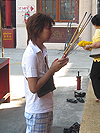|
incense stick
Name for both a
small wooden stick coated with a tick layer of
incense
and a solid stick completely made of incense material, without a supporting core.
There are many different colours (fig.) and they are made from a wide variety of
materials, both natural and artificial. They are often used at religious
ceremonies and spiritual purification rites, in places of worship of different
religions. There are several kinds, such as very thick and large incense sticks
used at special occasions like funerals (fig.), but the most commonly used incense
sticks in Thailand are small
joss sticks,
cored incense for religious practice that consist of a light coloured
incense on a usually purple or red wooden stick of about 20-30 cm long (fig.).
Incense sticks
are made from
bamboo, which is cut into
very thin sticks, of which one end, the one
that will serve as the handle, is dyed or painted in a certain colour, usually
red, and then dried (fig.).
In
Vietnam,
purple represents the
lotus (fig.),
i.e. the national flower of Vietnam (fig.),
and red that of the national flag (fig.),
as well as being a colour generally associated with good luck.
Then, the end
which has no dye on it is rolled in a sticky, dough-like mixture of
oil and
cinnamon, and then
dipped in fine sandalwood powder, which
serves as a coating and enhances combustion. Sometimes
charcoal is added to obtain a black colour. When this
process is completed, the incense sticks are laid out to
dry in the wind or sun once again, now to allow the incense
itself to harden. After that, the incense sticks are ready for use (fig.). Thai
Theravada Buddhists habitually burn three incense sticks at a time, symbolic for
the
Triratana, the three objects of
veneration for Buddhists, i.e. the
Buddha,
the
Dhamma,
and the
Sangha,
whereas Thai-Chinese Buddhists belonging to the
Hinayana sect tend to burn a whole bunch of incense sticks at
the same time. It is believed that when offering food, the scent of the incense
takes the food up to heaven as long as the
joss stick burns. Once the incense is
burned up the food is taken away, often for own consumption. Due to the large
amount of incense sticks burning simultaneously, especially in Chinese temples
and on auspicious days when large crowds of people gather to make merit, the
incense sticks are discarded before they are burned up completely (fig.)
and burned in
gong de
or joss ovens
(fig.), in order to make place for newly arrived
worshippers as well as to avoid suffocation in badly ventilated locations where
breathing may become difficult due to high emissions of carbon monoxide and concentration of smoke.
If they are not discarded they are sometimes left and piled up on top of each
other to form a tower of sticks (fig.).
Incense sticks
are also used for other than religious purposes, e.g. against mosquitoes or to enhance the smell in
ones home. Joss stick are usually burned in a special vessel called an incense
burner (fig.),
known in Thai as
kratahng toob, or
in a censer called
takan
(fig.)
used when burning incense such as cones for one.
Before burning incense sticks the person offering them will first make a vow
called
athitahn,
in which the hands are brought
together
above the head, making a
wai.
In Thai, incense sticks are called
toob, and
Bulrush (fig.)
is known as toob
reusi,
i.e. the
‘hermit's
incense
stick’.
See also
jieba,
miao, and
incense coil.
回






|

